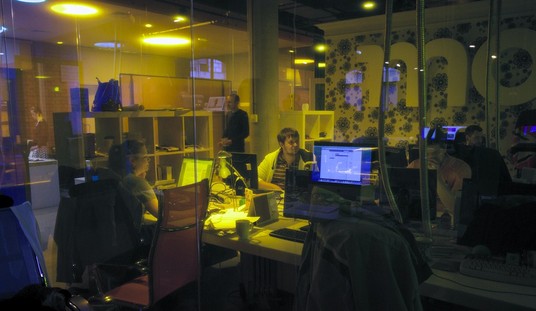Particularly given the ’80s theme that our graphic designer came up with for the Lifestyle blog, I’d be remiss if I didn’t point out that for their 80th podcast, our friends at Ricochet have an extensive interview with Kurt Loder. Loder was associated with first Rolling Stone and then MTV during that halcyon decade. Loder was editor of Rolling Stone when they were serializing the first draft of Tom Wolfe’s Bonfire of the Vanities and routinely running P.J. O’Rourke as their token libertarian, co-authored Tina Turner’s I, Tina autobiography and then joined MTV’s news division.
In any case, it’s worth clicking over for the Photoshopped image of James Lileks, Rob Long, and Peter Robinson under — shudder — ’80s-era mullets.
Speaking of MTV, at Hot Air, Jazz Shaw (who also contributes to PJM from time to time) asked at the start of the month, “Did video really kill the radio star?”
One of the most easily overlooked anniversaries in the midst of all the sound and fury over the debt fight is doubtless this one. It passed at precisely one minute past midnight, eastern standard time. Thirty years ago from that moment, MTV took to the air for the first time and their premiere offering – doubtless intended as a preemptive declaration of victory – was Video Killed the Radio Star by The Buggles.
For better or worse, it launched a new era in entertainment which quickly became an obsession in American culture. DJs had previously been able to hide behind microphones, often in lonely broadcast towers up on hilltops. If you ever saw them at all, it was likely just a press release head shot photo, possibly from their earlier, golden days. It didn’t matter if they were older, fat, balding or wearing a grease stained t-shirt. So long as the voice was right, they determined the fate of musicians across the land. (At least until the payola scandals hit.)
With the launch of MTV, a new generation of VJs became the fascination of young music fans. They had to be bright, glossy and dressed in the hippest way possible. (And now I just realized that nobody says “hip” any more. Dear God, I’ve gotten old.) But that craze just didn’t have the legs of the radio stars they sought to replace. While preparing this column I realized that I couldn’t recall the name of a single one of the original VJs except that there were two girls with the same name. (Don’t bother Googling it. They were Julie Brown and “Downtown” Julie Brown.)
In the end, MTV and their later competitor VH1 seemed to fall by the wayside, choosing to hitch their wagons to an endless stream of reality shows and other pop culture pablum. One frequent joke among folks of my age group includes the phrase, “back when MTV still played music videos.”
It’s true that MTV eventually devoured itself, but few remember the pitiful shape the music industry was in before the channel launched. Many thought videogames were the teenage wave of the future; rock records were a victim of the recession of the late 1970s and early 1980s. MTV initially helped keep the industry afloat, and within a few years inspired countless trends of its own — Miami Vice was said by many at the time to have begun as a note on NBC head honcho Brandon Tartikoff’s cocktail napkin with two words: MTV cops.
http://www.youtube.com/watch?v=Cw6xesXLIAA&feature=related










Join the conversation as a VIP Member